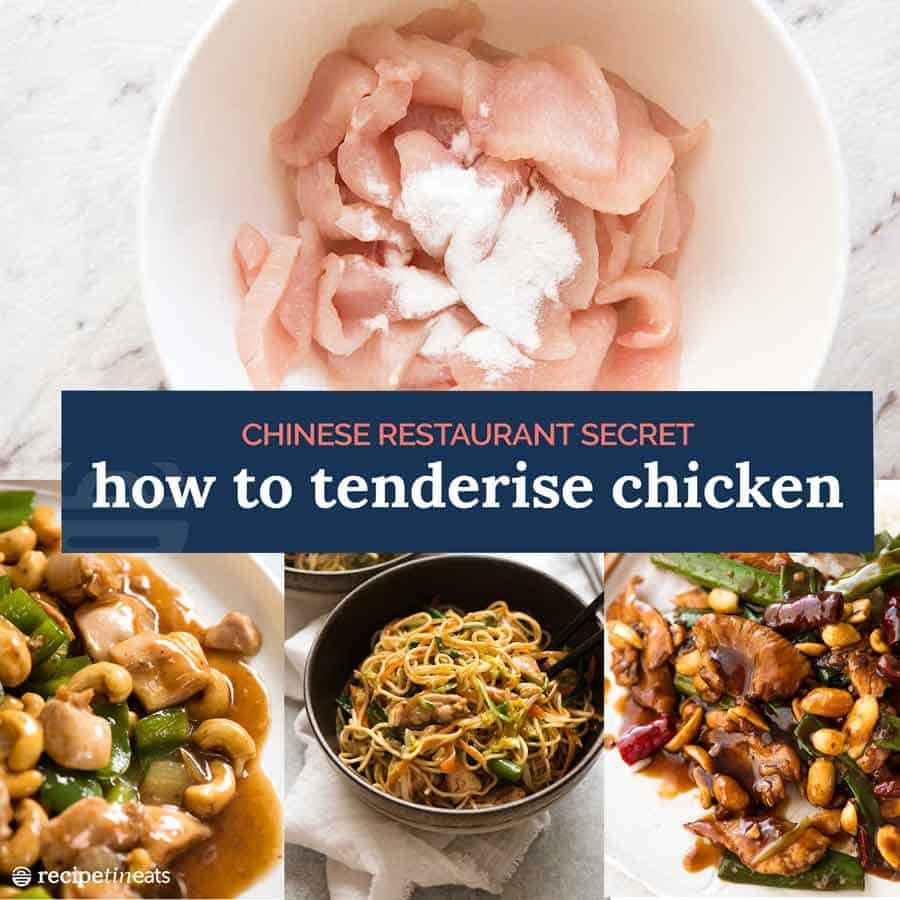What Do Chinese Restaurants Use for Chicken: Authentic Secrets
Chinese restaurants typically use boneless chicken thighs or breasts. They often marinate the meat for added flavor and tenderness.
Chinese cuisine places great importance on taste, texture, and presentation. Chicken is a staple protein in many dishes, and chefs prefer boneless thighs or breasts due to their versatility and ease of preparation. Marination is a common practice to enhance flavor, using ingredients like soy sauce, ginger, garlic, and rice wine.
This not only infuses the chicken with rich taste but also ensures it remains tender during cooking. Stir-frying, deep-frying, and steaming are popular cooking methods. These techniques ensure the chicken is succulent and perfectly complements various sauces and seasonings, creating delicious, memorable dishes.
:max_bytes(150000):strip_icc()/165436262820220603_125536VelvetingChicken4x3-df67512025b34d86b1ca027c1aa245c9.jpg)
Chicken Selection
Understanding the chicken selection process in Chinese restaurants gives insight into their delicious dishes. They focus on choosing the best cuts and ensuring high quality. This section dives into their preferences and sourcing methods.
Preferred Chicken Cuts
Chinese restaurants typically use specific cuts for their dishes. The most common cuts are:
- Chicken breast: Used for stir-fries and soups.
- Chicken thighs: Preferred for their juicy texture.
- Drumsticks: Often used in stews and braised dishes.
These cuts provide the right balance of flavor and texture. Chefs choose them to complement various sauces and cooking styles.
Quality And Sourcing
Quality is crucial for Chinese restaurants. They ensure the chicken is fresh and free from additives. Sourcing practices involve:
- Local farms: Many restaurants work with local farms to get fresh chicken.
- Reputable suppliers: They partner with trusted suppliers for consistent quality.
- Organic options: Some opt for organic chicken for healthier dishes.
These practices ensure every dish meets high standards. Fresh and high-quality chicken enhances the overall dining experience.

Marination Techniques
Marination is a crucial step in preparing delicious chicken dishes in Chinese cuisine. The right marination techniques can make chicken tender, juicy, and flavorful. Let’s explore the traditional ingredients and the ideal marination duration used by Chinese chefs.
Traditional Ingredients
Chinese marination often includes a variety of traditional ingredients. These elements add depth and richness to the chicken. Here are some common ingredients:
- Soy Sauce: Adds a savory and salty flavor.
- Hoisin Sauce: Provides a sweet and tangy taste.
- Shao Xing Wine: A type of rice wine for a unique aroma.
- Ginger: Adds a zesty and spicy kick.
- Garlic: Enhances the overall flavor profile.
- Five-Spice Powder: A mix of spices for a complex taste.
Marination Duration
The marination duration is crucial for achieving the best results. It allows the chicken to absorb all the flavors. Here is a guide:
| Type of Dish | Marination Time |
|---|---|
| Stir-Fry | 30 minutes to 1 hour |
| Grilled | 2 to 4 hours |
| Deep-Fried | 1 to 2 hours |
| Roasted | 4 to 8 hours |
For the best results, always marinate chicken in the refrigerator. This keeps the chicken fresh and safe to eat. Shorter marination times are suitable for quick-cooking methods like stir-frying. Longer marination times are ideal for grilling and roasting.
Velveting Process
The secret behind the tender and juicy chicken in Chinese dishes lies in a technique called the Velveting Process. This method ensures the meat remains soft and flavorful, making it a favorite in Chinese cuisine.
What Is Velveting?
Velveting is a cooking technique used to protect the chicken from overcooking. The chicken is marinated in a mixture of egg white, cornstarch, and rice wine. This forms a protective layer around the meat. It is then briefly blanched in hot oil or water. This step helps seal in the juices and keep the chicken tender.
Benefits Of Velveting
There are several benefits of velveting:
- Tender Texture: The chicken becomes soft and silky.
- Juicy Flavor: The meat retains its natural juices.
- Quick Cooking: The chicken cooks faster and more evenly.
- Enhanced Taste: The marinade adds a subtle flavor.
This technique is simple but delivers amazing results. Your chicken dishes will be delicious and loved by all.
Cooking Methods
Chinese restaurants are known for their delicious chicken dishes. The secret lies in their unique cooking methods. These methods bring out the best flavors and textures in the chicken. In this section, we will explore two popular cooking techniques: stir-frying and deep-frying.
Stir-frying
Stir-frying is a quick cooking method. It uses high heat and a small amount of oil. The chicken is cut into small, even pieces. This helps it cook evenly and quickly.
- Heat a wok or a large skillet.
- Add a small amount of oil.
- Once the oil is hot, add the chicken pieces.
- Stir constantly to cook all sides evenly.
- Add vegetables and sauces to enhance flavor.
This method keeps the chicken tender and juicy. The high heat seals in the juices, making each bite flavorful.
Deep-frying
Deep-frying is another popular method. It uses a lot of hot oil to cook the chicken. This method creates a crispy outer layer while keeping the inside moist.
- Heat a pot of oil to the right temperature.
- Coat the chicken pieces in a batter or breading.
- Carefully place the chicken into the hot oil.
- Fry until golden brown and crispy.
- Remove and drain on paper towels to remove excess oil.
Deep-frying gives the chicken a crunchy texture. The batter or breading adds an extra layer of flavor. This method is perfect for dishes like General Tso’s Chicken or Sweet and Sour Chicken.
Signature Sauces
Chinese restaurants are famous for their delicious chicken dishes. A big reason for this is their signature sauces. These sauces give the chicken unique flavors. Let’s explore some of these amazing sauces.
Soy Sauce-based
Soy sauce is a key ingredient in many Chinese dishes. It adds a salty and umami flavor. Here are some popular soy sauce-based sauces:
- Teriyaki Sauce: A mix of soy sauce, sugar, and mirin.
- Hoisin Sauce: A thick sauce made from soybeans, garlic, and spices.
- Oyster Sauce: Made from oyster extracts, soy sauce, and sugar.
Each of these sauces gives a rich taste to chicken dishes. They make the chicken juicy and flavorful. Soy sauce-based sauces are a staple in Chinese cuisine.
Sweet And Sour
Sweet and sour sauce is another favorite. It has a balanced taste of sweetness and tanginess. This sauce is perfect for chicken dishes. Here are the common ingredients:
| Ingredient | Description |
|---|---|
| Pineapple Juice | Gives a sweet and fruity flavor. |
| Vinegar | Adds tanginess to balance the sweetness. |
| Ketchup | Provides a rich and slightly sweet base. |
| Sugar | Enhances the overall sweetness. |
| Soy Sauce | Adds depth and umami flavor. |
Sweet and sour sauce makes chicken dishes exciting. The flavors burst in your mouth. This sauce is especially popular with kids.

Spices And Seasonings
Chinese restaurants are famous for their flavorful chicken dishes. The secret lies in their unique spices and seasonings. These ingredients create rich and complex flavors that delight the taste buds.
Commonly Used Spices
Chinese cuisine uses a variety of spices to flavor chicken dishes. Here are some of the most common ones:
| Spice | Flavor Profile |
|---|---|
| Ginger | Warm, spicy, and slightly sweet |
| Garlic | Pungent, savory, and aromatic |
| Sichuan Peppercorn | Tingly, numbing, and citrusy |
| Five-Spice Powder | Sweet, spicy, and earthy |
| Star Anise | Licorice-like and sweet |
Balancing Flavors
Balancing flavors is crucial in Chinese cooking. The goal is to create harmony between different tastes. Here are some tips used by Chinese chefs:
- Sweet and Sour: Use sugar and vinegar to balance each other.
- Salty and Spicy: Add soy sauce and chili to create depth.
- Umami: Incorporate ingredients like soy sauce, oyster sauce, and mushrooms.
- Fresh Herbs: Use cilantro and green onions for a fresh finish.
By using these techniques, Chinese restaurants achieve a perfect balance in their chicken dishes. The result is a flavorful and satisfying meal that keeps customers coming back for more.
Health And Nutrition
Chinese restaurants use special methods to make their chicken dishes delicious. These methods also keep the chicken healthy and nutritious. Let’s explore the health and nutrition aspects of Chinese restaurant chicken.
Healthy Cooking Practices
Chinese chefs use many healthy cooking practices. They often steam, stir-fry, or boil the chicken. These methods use less oil and keep the nutrients. Chefs also use fresh ingredients, which are good for you.
- Steaming: Keeps vitamins and minerals intact.
- Stir-frying: Uses less oil and cooks quickly.
- Boiling: Keeps the chicken moist and tasty.
Nutritional Benefits
Chicken in Chinese dishes offers many nutritional benefits. It is a good source of protein. Protein helps build and repair muscles. Chicken also has vitamins and minerals like B6 and niacin.
Here is a table showing the nutritional value of 100 grams of cooked chicken:
| Nutrient | Amount |
|---|---|
| Protein | 27 grams |
| Vitamin B6 | 0.5 mg |
| Niacin | 13.4 mg |
These nutrients are essential for your body. They help you stay strong and healthy.
Frequently Asked Questions
What Type Of Chicken Do Chinese Restaurants Use?
Chinese restaurants often use boneless, skinless chicken breast or thigh meat. These cuts are tender and cook quickly.
How Do Chinese Restaurants Tenderize Chicken?
Chinese restaurants use techniques like velveting with cornstarch and egg white. This makes the chicken tender and juicy.
What Oils Are Used For Cooking Chicken?
Chinese restaurants typically use vegetable oil or peanut oil. These oils have a high smoke point.
Do Chinese Restaurants Marinate Their Chicken?
Yes, they often marinate chicken in soy sauce, ginger, and garlic. This adds flavor and tenderness.
Conclusion
Understanding what Chinese restaurants use for chicken enhances your dining experience. They prioritize fresh ingredients and unique techniques. This knowledge can help you appreciate the rich flavors even more. Next time you dine, you’ll have a deeper insight into the culinary artistry behind your favorite dishes.
Enjoy the journey of exploring Chinese cuisine!






